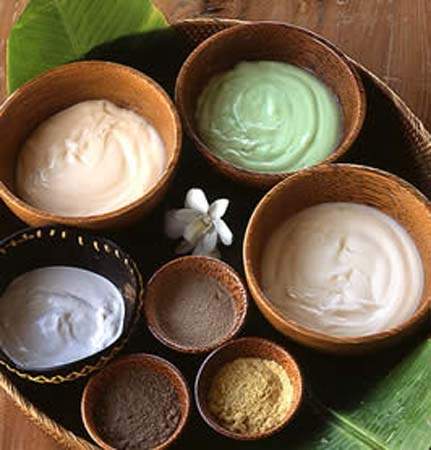 Clays have been used by all living creatures since the beginning of life on Earth. Animals and birds eat clays when sick, roll in them to clean their bodies, as well as to free themselves of parasites, heal wounds & ulcers. Ancient Egyptians have been using clays for mummification. Cleopatra used clay from the Nile river and the Arabian desert in her beauty treatments.
Clays have been used by all living creatures since the beginning of life on Earth. Animals and birds eat clays when sick, roll in them to clean their bodies, as well as to free themselves of parasites, heal wounds & ulcers. Ancient Egyptians have been using clays for mummification. Cleopatra used clay from the Nile river and the Arabian desert in her beauty treatments.
There is plentiful evidence of clay used by ancient spas built 3-4000 years ago. Many of these spas still exist and continue using clay. The doctors in the ancient civilisations (Dioscortes, Avicenna, Galen) used clay to treat their patients for many health problems.
And they did have very advanced treatments and remedies available to them. ” . . . a hill in the island of Lemnos . . . in the northern Aegean Sea has produced this `earth` . . . reddish-yellow clay . . . from before Theophrastus’ time (372-287 B.C.) down to the present day.
According to Dana (System of Mineralogy 689), it is cimolite, a hydrous silicate of aluminium.
The Ancients distinguished two kinds – one sort used as a pigment, and the other for medicinal purposes. This latter was dug with great ceremony at a certain time of the year, moulded into cubes, and stamped with a goat – the symbol of Diana. It thus became known as terra sigillata and was an article of apothecary commerce down to the last century. It is described by Galen (xii., 12), Dioscorides (v., 63), and Pliny (xxxv., 14), as a remedy for ulcers and snake bites.” Alexander the Great’s troops and Roman soldiers used to take clays with them on long marches to ward off hunger and food poisoning. American Indians used and are still using clays in spiritual ceremonies and for healing.
African tribes used and are still using clay for similar purposes. African women have been observed to eat “dirt” when pregnant or lactating. In societies which have not lost touch with nature, clay takes a very high position as a medicine, preventative remedy and food. Clay is also used for water purification where clean water is difficult or impossible to obtain.
For generations, clay has been eaten by starving nations at times of hunger. Even now in poorer countries clays (mud pies) are made and eaten when food is short (Philippines, New Guinea, Costa Rica, Guatemala and the Amazon and Orinoco basins of South America). I have recently come across an article about pregnant women in Haiti eating mud pies. There are arguments that the mud pies are a tradition in certain nations and are eaten as a natural mineral supplement.
Throughout the two World wars clays were part of Russian, French and German soldiers’ rations to prevent and treat food poisoning, diarrhoea, as well as wound infections. Many lives and limbs have been saved by humble clay. “Under the name of ‘Cutler’s earth’ clay was used in some districts of France – and perhaps it is still used – as a resolutive and against burns from first to third degree.
It is also known under the names of Luvos, aluminium silicate, colloidal white clay, balus, and others.” (Our Earth, Our Cure by Raymond Dextreit, 1993, p.14). German naturopaths Kneipp, Kuhn, Felke, Just used clays for medicinal purposes. Father Kneipp used clay and vinegar poultices in his practice – the remedy still used in naturopathic practices today. Another German naturopath Professor Julius Stumpf treated Asiatic cholera when antibiotics such as penicillin had to wait for another few decades to appear.
Bentonite clay and zeolite were used in Ukraine to decontaminate the area after the Chernobyl nuclear disaster. Huge amounts were used to bury the reactors. They were also given to the personnel and the local population in the form of food/ drinks to take radioactive elements and heavy metals out of the body.
Russia has been using clays, alongside muds, at medical spas, resorts and sanatoria to treat chronic and acute diseases for centuries, thanks to its vast reserves of therapeutic peloids. European, Mediterranean resorts are famous for it too. Clays, especially the ones extracted from salt lakes, are used to treat psoriasis, eczema, musculoskeletal, genitourinary, circulatory and numerous other disorders.
Clays are routinely used and prescribed both by doctors and naturopaths for many health conditions in France. French clays are very well known and valued among clay users, as well as drugs and cosmetics manufacturers. Recently, French Green clay has been popularised by the Independent newspaper in the UK as an effective antibiotic against hospital superbugs.
The late French doctor, Lyne Brunet de Courssou, successfully treated many of her patients in Ivory Coast (Africa) for a horrific flesh-eating disease – Buruli ulcers – with French Green Clays. The results were staggering even in the most advanced cases.
As can be seen from these examples, clays have a very long history not only as ingredients in beauty procedures but as potent remedies used in detoxification and healing of many conditions. They have also saved countless lives during wars and nuclear accidents. Let’s take our hats off to the humble clays, and treat them with the respect they deserve.
You can read more about clays, their interesting history and why they are such a powerful health and beauty remedy in my book – “How Clays Work”, available on Amazon. The book is a result of years of my research into the science and properties of clays. It gives in-depth information about how and why clays should be used by all of us.

